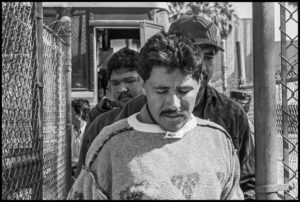Photos and text © 2019, by David Bacon
The Nation

Mexicali, Baja California – 1996
A worker is deported back into Mexico at the border gate, from a bus that has taken deportees from the detention center in El Centro in the Imperial Valley, on the other side of the fence.
Editors’ note: “If it happened yesterday, we’ve already forgotten.” – an anonymous Nation editor.
What we see and react to in the media conditions us to view the present as a series of immediate crises, and to ignore their roots in the past. For social justice movements, this can be deadly, cutting us off from an ability to weigh and learn from our own history, and to understand how that history shapes the ways we fight for justice today.
In this photo essay, David Bacon reaches into his photographic archive of 30 years, which are now part of the Special Collections of Stanford University’s Green Library. A Nation contributor and former union organizer, Bacon’s photographs and journalism have documented the courage of people struggling for social and economic justice in countries around the world.
____________________
In 1971, Pat Nixon, wife of Republican President Richard Nixon, inaugurated Border Field State Park, where the border meets the Pacific Ocean just south of San Diego. The day she visited, she asked the Border Patrol to cut the barbed wire so she could greet the Mexicans who’d come to see her. She told them, “I hope there won’t be a fence here too much longer.”
Instead, a real fence was built in the early 1990s, made of metal sheets taken from decommissioned aircraft carrier landing platforms. The sheets had holes, so anyone could peek through to the other side. But for the first time, people coming from each side could no longer physically mix together or hug each other. This is how the wall looked when I began photographing it, over 30 years ago.
That old wall still exists in a few places on the Mexican side in Tijuana and elsewhere. But Operation Gatekeeper, the Clinton Administration border enforcement program, sought to push border crossers out of urban areas like San Ysidro, into remote desert regions where crossing was much more difficult and dangerous. To do that, the government had contractors build a series of walls that were harder to cross.
That’s partly how the US-Mexico border became more than mere geography-how it became instead a passage of fire, an ordeal that must be survived in order to send money from work in the US back to a hungry family, to find children and relatives from whom they have been separated by earlier journeys, or to flee an environment that has become too dangerous to bear.
Some do not survive, dying as they try to cross the desert or swim the Rio Bravo. To them the border region has become a land of death. Every year at least 3-400 people die trying to cross, and are buried, often without names, in places like the graveyard in Holtville, in the Imperial Valley.
But the photographs I’ve taken over 30 years also show that the US/Mexico border is a land of the living. Millions of people live and work on Mexico’s side of the border: There are the child laborers who pick the tomatoes and strawberries in Mexicali Valley that line the shelves of grocery stores in the US; there are the workers from across Mexico who staff the massive maquiladoras in Tijuana; And there are thousands who have been deported to Mexico, and who must now somehow survive this passage of fire as well.
